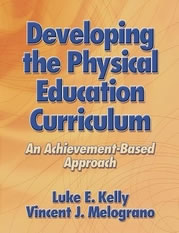MEDIA
REVIEW
Target Audience/Purpose:
This book was written for an audience that includes college
students studying to become physical educators, as a text
for a Curriculum and Instruction class, for beginning teachers,
and even for veteran teachers who wish to learn how to develop
a comprehensive Physical Education curriculum that is based
on student achievement of instructional and program objectives.
Content:
The book is presented in four parts: understanding of Physical
Education (PE) curriculum development, PE Curriculum Planning,
Implementation, and evaluation and dissemination of the PE
curriculum. The central model in the book is known as Achievement
Based Curriculum, or ABC. This model is based on the work
of one of the authors and another colleague, and is introduced
in depth in Part 1 of the book, after a review of Physical
Education philosophies mandates, standards, and curriculum
models.
The authors provide a graphic of the five part model on page
67. This graphic is repeated in other parts and chapters of
the book, where the relevant component of the model is highlighted.
They emphasize that Achievement Based Curriculum is "a
model for translating curriculum theory into a functional
curriculum" (p. ix, Preface), and does not prescribe
a particular philosophical approach, or curriculum "mandate."
Instead, the model provides a scaffold for systematically
developing a process, from writing program philosophy and
goals, through curricular objectives, program, unit and lesson
planning, to program evaluation and improvement based on student
learning outcomes. Thus the model can be customized for individual
districts, schools and programs.
A key concept of the book is what the authors call "Plan
Down, Implement Up" (illustrated by a graphic on page
10). This process is congruent with the Understanding
By Design approach of Grant Wiggins & Jay McTighe.
The essence is for programs to assess their knowledge base,
decide where they are going (or taking their students), how
they will know when they get there (assessing student outcomes),
and planning learning experiences to help student achieve
the learning outcomes/objectives.
The authors move from a broad, macroscopic perspective of
planning down, which includes developing essential themes
and objectives throughout the scope and sequence of the curriculum,
to dividing these objectives by the amount of scheduled time
and providing estimates of time assigned to each essential
objective, and then to the specifics of developing assessments
for the objectives and planning of lessons that will lead
to student accomplishment of those objectives.
In the last part of the book the authors discuss evaluation,
moving from individual assessment of student outcomes, to
aggregate assessment of unit, class and program outcomes,
to program evaluation based on student achievement. They emphasize
making program and instructional decisions based on evidence
provided by assessment data, as well as reflective practice
based on the data and on implementation of the curriculum.
In addition, they discuss use of assessment data to provide
information to students, administrators and parents about
program outcomes, as well as their potential for advocacy.
An important theme in the book is that teachers need to work
together (often in small groups), systematically, to develop
the curriculum ("plan down") and to put it into
effect ("implement up"). Another is that assessment
is key, and should be based on student achievement. This in
turn leads to the emphasis on gathering systematic data as
evidence of student achievement and acting on that data by
evaluating the extent to which objectives were met, and what
needs to be done to maintain successful outcomes and to change
unsuccessful outcomes.
Finally, the authors recognize the complexity and immensity
of the task of planning the curriculum, and recommend an incremental
approach, starting with more manageable, smaller areas of
implementation and building from there.
Strengths/ Limitations:
The strength of this book is in its systematic approach
and its alignment with other curriculum movements, like Understanding
By Design, that emphasize backward planning approaches
and assessment based on student performance. Although there
is a great deal of information in the book, and many new (or
even veteran) teachers will be daunted by the task of curriculum
revision or design, the constant reiteration of the model
and its five iterative components helps would-be curriculum
designers keep their "eye on the prize" of student
achievement.
In addition, each chapter provides charts, tables and templates
that will help both planning and implementation. The whole
process of planning and implementation is supported with a
planning case study in Appendix A, and planning worksheets
and templates in Appendix B.
Each chapter of the book begins with a "case study"
in which the reader is asked to immerse themselves and respond
to a scenario that will affect planning and implementing curriculum.
This provides a "real world" context for the chapter
focus and helps the reader visualize how they might go about
the process. Each chapter ends with a section called "Making
It Work," in which the authors respond to "real
world" questions and concerns that teachers would have
if they were to attempt to plan and implement curricular designs
and/or revisions.
While the characteristics of the book will undoubtedly help
those who wish to design/develop their Physical Education
curriculum, the book does contain a dizzying array of acronyms
(such as TLMs, YTLMs and BTLMs, pp. 131-133; CMG, CAM and
TE, pp. 263-265). Perhaps in a book of this length and complexity
this is inevitable. Some of the acronyms are identified in
the Index.
Summary:
This is a text that one would expect to see used for a Curriculum
and Instruction course in a Physical Education Teacher Preparation
program. However, it would also be appropriate for new teachers
and teachers in the field to use as a tool for developing
and/or revising curriculum. The achievement-based approach
allows for schools and districts to use the text to develop
curriculum customized to their particular needs and resources.
The systematic and comprehensive nature of the book provides
a scaffold for motivated professionals to move through the
entire curriculum process from preparing to plan, planning,
implementing, evaluating, reporting and revising, and is illustrative
of good curriculum planning, which is an ongoing process.
Recommendation:
The authors themselves note that teachers generally do not
have incentives to plan and revise curriculum or even to gather,
analyze and report on data in order to improve student achievement.
For the intrinsically motivated Physical Educators in the
field or about to go out into the field, this book can provided
a detailed, systematic and comprehensive program planning
companion, one that they will need in the complex, sometimes
daunting, but potentially extremely rewarding, process of
curriculum development.
 Reviewer: Reviewer:
Peter Rattigan, PhD.
Associate Professor
Rowan University
Glassboro, NJ
Rattigan@rowan.edu
I am Chair of the department of Health and Exercise Science.
I teach pedagogy and technology courses to Health and Physical
Education teacher candidates, co teach Clinical Practice Seminar,
and supervise student teachers. I have also taught classes
for the College of Education on Learning Communities, both
undergraduate and graduate, and have taught an on line course,
Computers in the Curriculum, for the College of Graduate
and Continuing Education.
I came to Rowan in September 2000, after 14 years teaching
in K-12 health and physical education in the UK and US, and
a total of five years as a teaching assistant at the University
of Minnesota, Minneapolis. I am in my 30th year of teaching!
To Main MEDIA
Review Page
(back
to pelinks4u homepage) |





 Reviewer:
Reviewer: